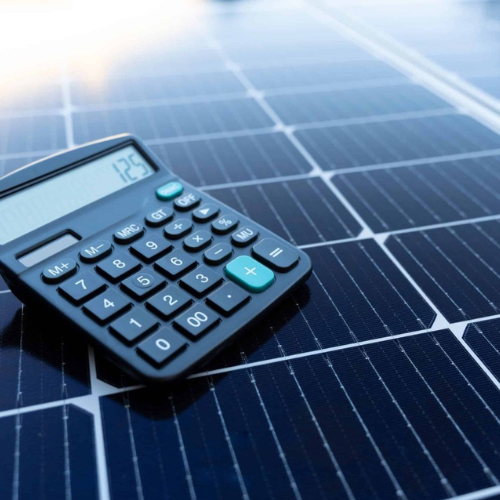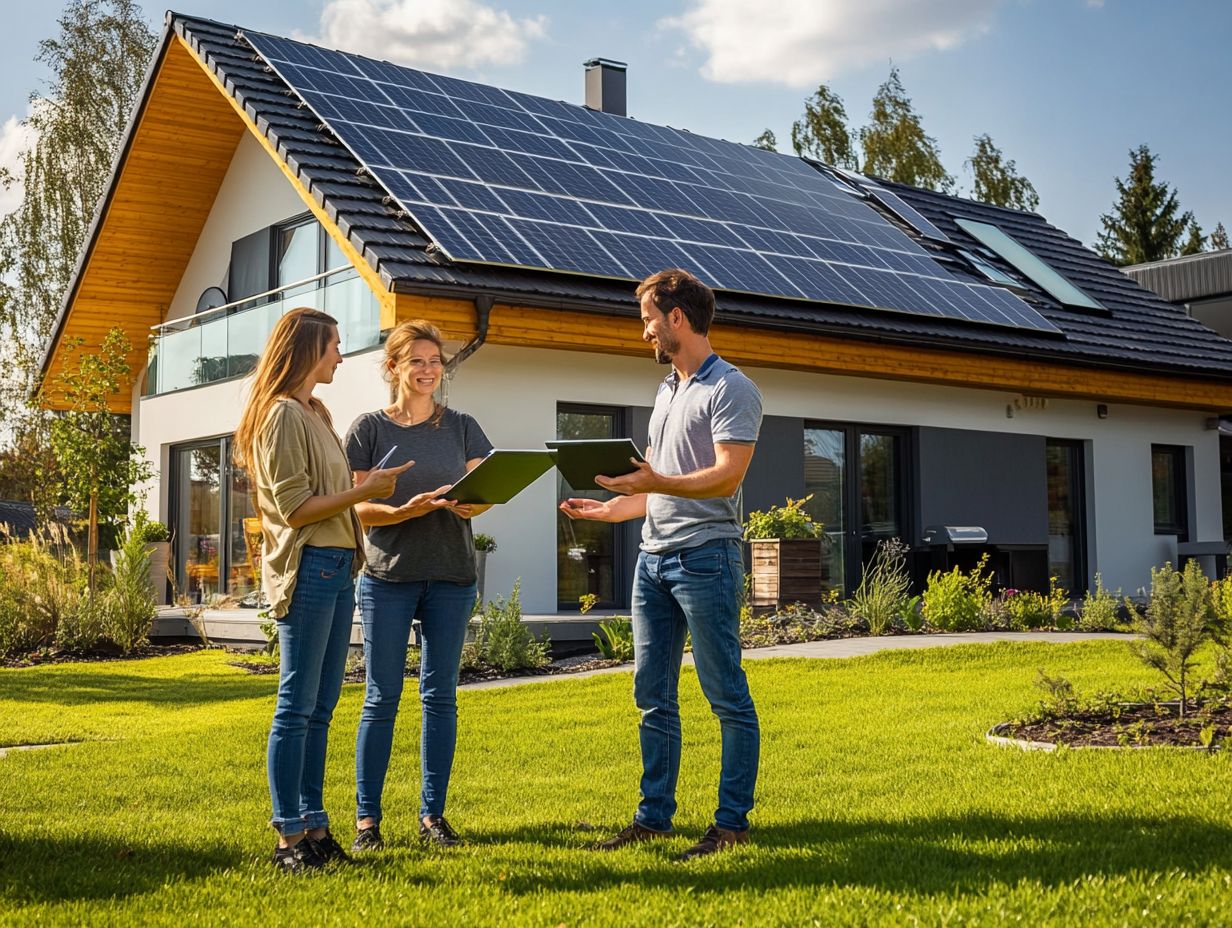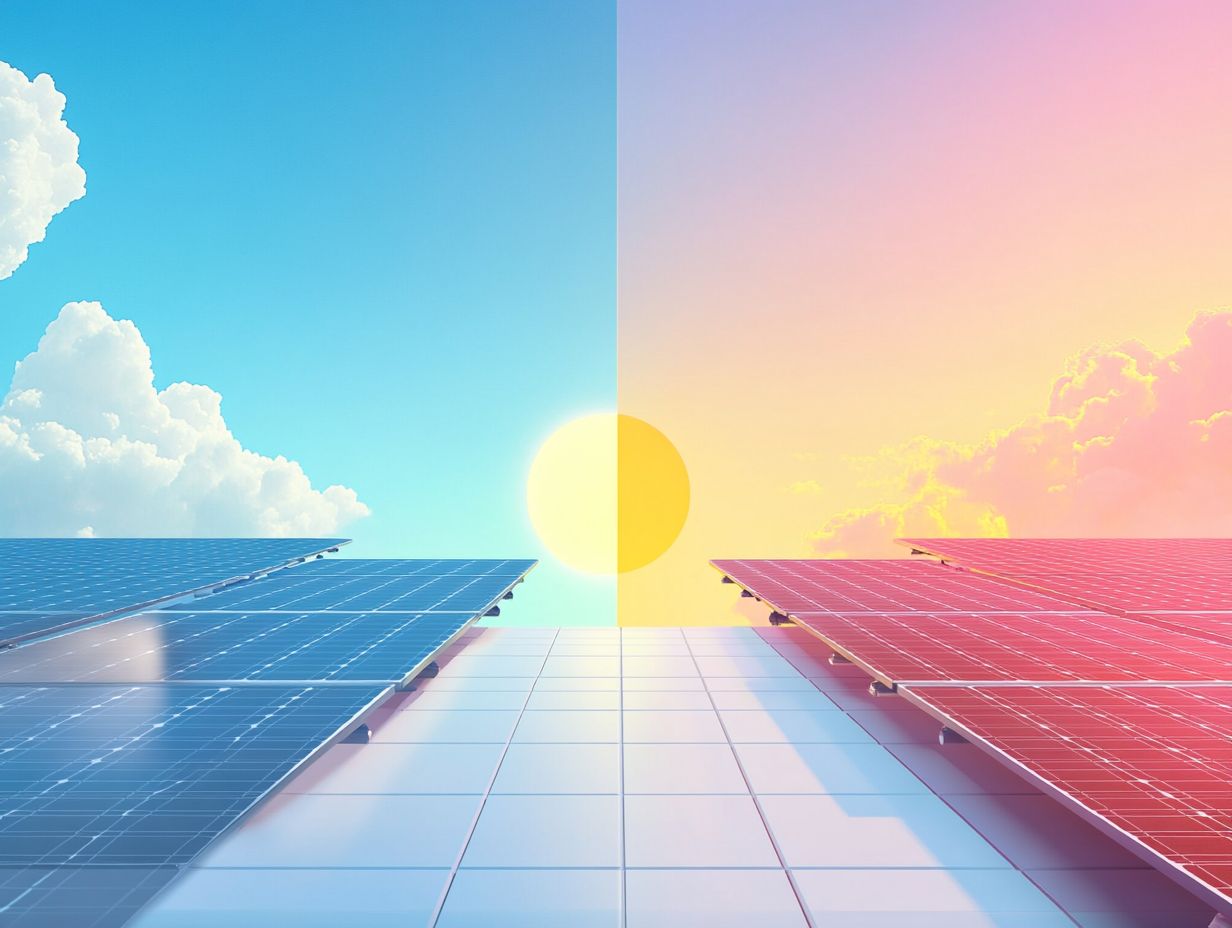Contents
- 1 Why Proper Sizing is Crucial for Solar Panel Systems
- 2 Factors to Consider for Sizing a Solar Panel System
- 3 Essential Tools and Methods for Sizing Your Solar Panel System
- 4 Step-by-Step Guide for Sizing a Solar Panel System
- 5 Common Mistakes to Avoid When Sizing Your Solar Panel System
- 6 Frequently Asked Questions (FAQs)
- 6.1 What is a solar panel system sizing tool?
- 6.2 Why is it important to use a solar panel system sizing tool?
- 6.3 How Does a Solar Panel System Sizing Tool Work?
- 6.4 Can I use a solar panel system sizing tool for any location?
- 6.5 Do I need any technical knowledge to use a solar panel system sizing tool?
Why Proper Sizing is Crucial for Solar Panel Systems

Properly sizing your solar panel system is key to maximizing energy efficiency and making sure it meets your specific energy consumption needs.
This not only leads to significant energy savings but also helps lower your carbon footprint and minimize environmental impact.
When you have a well-sized solar installation, you can boost your energy independence by cutting down on utility bills and making the most of the sunlight exposure you have, whether you’re going for a grid-tied system or an off-grid system.
Plus, grasping the system’s capacity through careful sizing can really help optimize performance ratios and efficiency ratings, which ultimately impacts your return on investment (ROI).
Green, M. A., Dunlop, E. D., Hohl-Ebinger, J., Yoshita, M., Kopidakis, N., & Hao, X. (2020). Solar cell efficiency tables (version 56). Progress in Photovoltaics: Research and Applications, 28(7), 629-638. Link
Strategies for Maximizing Efficiency and Cost Savings
To get the most out of solar energy and save some cash in the process, you really need to dive into a thorough analysis of your energy needs and take advantage of the financial incentives out there, like tax credits and rebate programs.
This includes a close examination of your current energy consumption patterns and monitoring the performance of your solar system to make sure it’s generating clean energy effectively.
By regularly checking the system’s output, you can spot any potential issues early on, which boosts reliability and efficiency.
Doing a comprehensive financial analysis is also key to understanding your long-term savings on utility bills, which can really help offset those initial installation costs.
When you combine these strategies with the available financial incentives, it makes a strong case for going solar, cutting down on expenses while also being eco-friendly and promoting renewable energy.
Factors to Consider for Sizing a Solar Panel System
Several critical factors must be carefully considered when sizing your solar panel system, including system components and site location.
Think about your energy consumption patterns, analyze your location, and take a look at the climate conditions in your area, and conduct a solar resource assessment.
Don’t forget to factor in your budget constraints and the available space for installation, too.
Each of these elements is essential in figuring out the optimal system capacity that will help you maximize solar output and efficiency.
Energy Needs and Usage Patterns
Understanding your energy needs and usage patterns is crucial for effective load calculation and ensuring your solar panel system meets your electricity usage throughout the year.
By conducting a thorough energy audit and site assessment, you can pinpoint when you use the most electricity, which helps you tailor the solar panel sizing process to match your consumption patterns perfectly.
This assessment becomes super valuable when you’re thinking about integrating renewable energy sources. It ensures that your system is not only optimized for efficiency but also in sync with the natural flow of sunlight.
Identifying the hours when your energy demand peaks can really guide your decisions, allowing you to strategically install your system to make the most of those prime sunlight hours.
Ultimately, this alignment helps create a more resilient renewable energy solution, leading to significant cost savings and boosting your sustainability game.
Location and Climate
Location and climate play a big role in how much sunlight exposure and solar radiation your solar panel system receives, which in turn affects its efficiency rating and performance.
These factors not only determine how much sunlight you’ll receive but also the quality of energy produced, and that can vary a lot depending on where you are and what the weather’s like.
For example, if you’re in an area with heavy cloud cover or frequent rain, you might find your solar output isn’t as high as in sunnier places.
It’s also a good idea to do a shading analysis since nearby trees, buildings, or other obstacles can block sunlight and reduce the energy your panels can capture.
To really boost your system’s performance, you should properly adjust the angle of tilt and make sure your panels are oriented just right—usually facing south if you’re in the northern hemisphere.
This adjustment can significantly enhance the efficiency of your solar installation in converting sunlight into usable energy.
Budget and Available Space
Your budget and the available space for installation are crucial for solar system design, as they directly impact the overall installation cost and your potential return on investment (ROI).
To navigate these factors effectively, you need to take a close look at your property’s specific energy needs and the orientation of the space you have for the solar module installation.
By understanding how much energy you require and how much sunlight that area gets throughout the year, you can make more informed decisions.
Don’t forget about financial incentives like tax credits, rebates, and financing options. These can significantly influence not just your initial investment but also the overall cost analysis of the system.
Incorporating these incentives into your budgeting process is essential for a complete understanding of affordability and the long-term benefits you can expect.
Essential Tools and Methods for Sizing Your Solar Panel System

You’ve got a bunch of tools and methods at your disposal for accurately sizing a solar panel system, such as photovoltaic cells and solar technology.
Whether you prefer online solar calculators, energy modeling software, or even good old-fashioned manual calculations, you can find a comprehensive approach that works for you.
Online Calculators and Software
Online calculators and software tools have become your go-to resources for accurately sizing solar panel systems.
They offer user-friendly interfaces and provide output predictions based on your inputs and specific energy needs.
These tools are perfect for everyone, whether you’re a residential solar enthusiast or into commercial solar projects.
They guide you through a series of straightforward steps to figure out how many panels you actually need for your unique situation.
By just entering details like your location, energy consumption habits, and roof specifications, you’ll get tailored suggestions that help ensure efficiency and cost-effectiveness.
Many of these apps even include graphical representations to make things clearer, while some advanced software offers simulations to predict long-term energy production.
In the end, the precision of these calculators helps you make informed decisions, maximizing your energy savings and minimizing your environmental impact.
Manual Calculations and Formulas
You can rely on manual calculations using established formulas for sizing your solar panel system. This approach emphasizes accuracy in load calculations, ensuring that the performance ratio aligns with your energy expectations and solar output.
Understanding the basic formulas is key, as it sets the stage for figuring out how many panels you need to generate the energy output you want.
The process starts with assessing your energy consumption patterns, usually measured in kilowatt-hours (kWh) over time.
Then, you can estimate potential solar production based on the amount of sunlight available in your area, which can vary quite a bit depending on where you live and the time of year.
By carefully calculating the performance ratio, you can see how effectively your solar panel system is converting sunlight exposure into usable electricity generation.
This relationship between performance ratio and energy modeling not only boosts system efficiency but also helps you make informed decisions about your future energy needs.
Step-by-Step Guide for Sizing a Solar Panel System
When you’re sizing a solar panel system, it’s all about taking a systematic approach. Start by figuring out your energy needs, then move on to selecting the right solar panels.
After that, you’ll need to calculate how many panels you’ll require and keep in mind any potential system losses that could affect the overall efficiency. It’s a bit of a process, but breaking it down makes it manageable.
Determining Energy Needs
Determining your energy needs is the first and most crucial step in sizing your solar panel system. It all starts with a load calculation based on your electricity usage and any future energy plans you might have.
This foundational process is essential as it provides insight into your current electricity consumption and prepares you for potential changes in usage patterns in the future.
By taking stock of your existing appliances and considering any anticipated additions—like electric vehicles or plans for home expansions—you can paint a clear picture of your energy demand.
Understanding this demand helps you choose the right system size, making sure your solar installation is both efficient and cost-effective.
Plus, effective energy audits can reveal areas where you can improve energy savings, leading to a more sustainable home and significant cost reductions over time.
Choosing the Right Solar Panels
Selecting the right solar panels is key to optimizing your system’s efficiency and making sure your photovoltaic modules meet your energy needs and installation requirements.
When you’re evaluating solar panels, one crucial factor to consider is their efficiency ratings. These ratings show how much sunlight gets converted into usable electricity.
Generally, higher efficiency ratings mean better energy output, especially if you’re working with limited space on your rooftop solar installation or solar array.
Don’t forget to check out the manufacturer specifications, like warranty periods and certifications for your photovoltaic modules, as these can indicate quality and reliability.
A reputable manufacturer will usually provide thorough documentation detailing performance in different conditions, which is a great way to ensure the longevity and effectiveness of your system.
By prioritizing these criteria, you can significantly enhance the overall performance and sustainability of your solar energy installation. This approach also enhances your energy efficiency and power optimization.
Calculating the Number of Panels Needed for Solar Power Generation

Calculating how many solar panels you need starts with understanding your system capacity, energy output requirements, and performance ratio to hit your energy goals measured in kilowatt-hours. Using a solar calculator can simplify this process.
- First things first, you need to figure out your household or facility’s total energy consumption, measured in kilowatt-hours (kWh).
This number will be your starting point for how much energy your solar installation needs to generate, taking into account renewable energy standards and net metering policies. - Once you have that baseline, you’ll apply the performance ratio—usually between 0.75 and 0.85—to account for those pesky inefficiencies like shading, temperature variations, and system losses.
A thorough shading analysis during the site assessment can help mitigate some of these losses. - Now, take the total required kWh and divide it by the expected energy output of each panel, adjusted for that performance ratio.
This will give you an accurate count of how many solar panels you’ll need to efficiently meet your energy needs and minimize your carbon footprint.
This thoughtful approach makes sure your solar energy system is perfectly tailored, maximizing your energy savings and sustainability.
Accounting for System Losses
Accounting for system losses is a crucial part of the sizing process. It helps ensure that your calculations reflect real-world conditions and performance ratios, which ultimately impact the expected energy output and overall solar efficiency, optimizing your energy performance.
Understanding the various types of system losses, such as shading, soiling, and temperature effects, is essential for optimizing your solar setup and maximizing your return on investment.
These losses can significantly reduce performance, leading to lower-than-expected energy generation.
For example, shading from nearby trees or buildings can cut down the sunlight reaching your panels, and dirt buildup can also put a damper on performance. Effective site location and routine solar maintenance can mitigate these issues.
To tackle these problems, you can implement regular maintenance and make smart installation choices—like the orientation and tilt of your panels.
Choosing high-efficiency modules designed to minimize losses can further boost your overall output and ensure that you get more reliable energy production over time.
Additionally, incorporating energy storage systems, such as a battery storage solution, can help manage energy distribution effectively.
Common Mistakes to Avoid When Sizing Your Solar Panel System
Avoiding common mistakes when sizing your solar panel system can save you both time and money, and improve the overall environmental impact of your solar energy solution.
Some key pitfalls to watch out for include:
- Underestimating your energy needs
- Ignoring important climate and location factors that can impact solar efficiency
National Renewable Energy Laboratory (NREL). (2015). Best Practices in PV System Installation. Link
Underestimating Energy Needs During Load Calculation
Underestimating your energy needs during the load calculation process can really set you up for a solar panel system that just can’t keep up with your household or business electricity usage, not to mention any future growth you might have in mind. A comprehensive energy audit can help avoid these pitfalls.
When that happens, you might end up with a system that struggles to meet your daily demands, which could push you to rely on less sustainable energy sources or rack up extra costs to cover your power supply.
To avoid falling into this trap, it’s crucial to conduct thorough energy audits that look at not just your current consumption, but also any future increases that could come from changes in your lifestyle or expanding tech needs.
By taking the time to evaluate these factors accurately, you can make sure your solar system is strong enough to handle fluctuations and peak usage times. Ignoring this step could lead to significant financial losses and may even hurt your energy independence in the long run.
Ignoring Climate and Location Factors in Solar System Design
If you ignore climate and location factors when sizing your solar panel system, you might end up with something that underperforms. Sunlight exposure and shading analysis are key to figuring out how efficient your system will be.
A detailed solar resource assessment can be highly beneficial in this regard.
These elements affect solar radiation levels, which directly influence how much energy your system can produce. For example, if you’re in an area with constant cloud cover or frequent rain, you could be getting way less solar energy than sunnier spots.
Understanding your local weather patterns, like wind and temperature changes, is crucial for optimizing your solar panel layout and ensuring you get the maximum output.
By doing a thorough analysis of your site location, you can better predict seasonal changes in solar exposure. This way, you can design a system that not only meets your immediate energy needs but also remains effective over time.
Not Considering Future Energy Needs
If you overlook future energy needs during the sizing process, you may encounter challenges in the future.
As your energy consumption changes or increases, you could find yourself stuck with a system that can’t adapt without shelling out for costly upgrades.
Considering demand response strategies can help mitigate these issues.
It’s important to remember that energy demands aren’t set in stone; they change as your business grows, technology advances, and your consumption patterns shift.
By anticipating these changes, you can lay the groundwork for a scalable energy strategy, making sure your system stays efficient and can handle usage shifts without major disruptions.
This approach also supports long-term financial savings and energy independence.
This kind of foresight allows you to make smart decisions about the size and type of equipment you need, minimizing the risk of overbuilding or underbuilding capacity.
In the end, taking this proactive approach enhances sustainability and operational efficiency, leading to long-term cost savings and reliability.
Frequently Asked Questions (FAQs)

What is a solar panel system sizing tool?
A solar panel system sizing tool is a software or online calculator that helps determine the appropriate size and number of solar panels needed for a specific project or location.
Why is it important to use a solar panel system sizing tool?
Using a solar panel system sizing tool is important because it ensures that the solar panel system is properly sized to meet the energy needs of the project, maximizing efficiency, cost-effectiveness, and environmental benefits.
How Does a Solar Panel System Sizing Tool Work?
A solar panel system sizing tool takes into account factors such as location, roof size, energy usage, and panel efficiency to calculate the optimal number of solar panels needed for a specific project.
Can I use a solar panel system sizing tool for any location?
Yes, most solar panel system sizing tools are designed to work for any location worldwide, taking into account variations in sunlight, temperature, and other factors.
Do I need any technical knowledge to use a solar panel system sizing tool?
No, you do not need any technical knowledge to use a solar panel system sizing tool. These tools are user-friendly and designed for individuals without a technical background.
No, most solar panel system sizing tools are user-friendly and do not require any technical knowledge. However, having basic knowledge about solar panels and energy consumption can help in understanding the results better.







